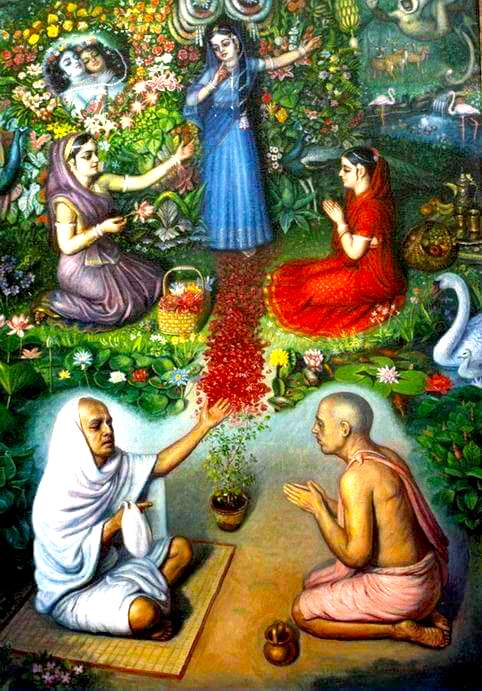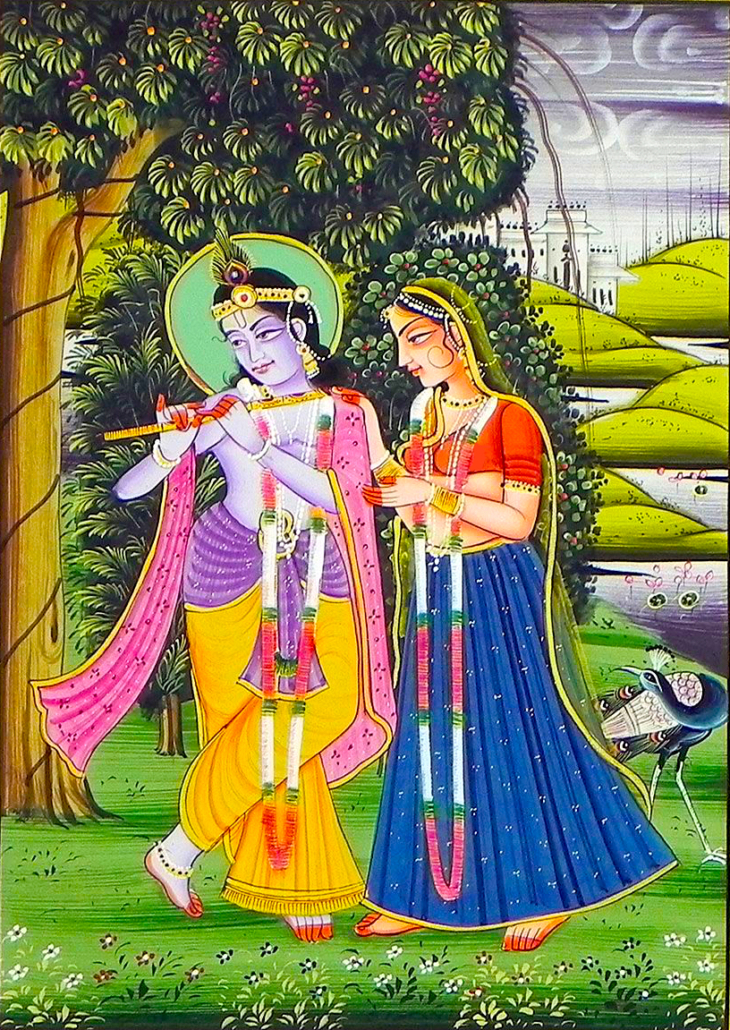Mahanidhi Madan Gopal Das
SRI GURU GIVES THE SIDDHA DEHA
The reception of a disciple’s eternal transcendental form, siddha deha, begins with receiving a siddha bhava from Sri Guru at the time of diksha.
The Guru’s individual siddha bhava i.e. one’s eternal fixed loving relationship with Sri Krishna (sthayi-rati) is hidden within the Gopal and Kama-gayatri mantras Sri Guru gives at the time of diksha. Sri Sanatana Goswami confirms the non-difference of Sri Guru and the diksha mantras:
yo- mantra -sa -guruh -sakshad -yo -guruh -sa -harih -svayam
Sri Brahmaji said (Vaman Kalpa), “The diksha mantra is identical to the Guru and the Guru is identical to Bhagavan Sri Hari Himself.” (Bhakti Sandarbha 237: Hari Bhakti Vilasa 4.353). Thus by chanting the diksha mantas, the sincere disciple gradually develops the same sthayi-rati, siddha bhava, as that of Sri Guru.
Right at the time of diksha, the Guru may give a siddha deha to an exceptionally qualified disciple. But usually this is done after some time. One can think that the following direct words of Sri Caitanya Mahaprabhu indicate receiving a siddha deha from Sri Guru at the time of diksha:
diksha -kale -bhakta -kare -atma-samarpana
sei-kale –krishna -tare -kare atma-sama
“At the time diksha, when a disciple fully surrenders to Sri Guru, Sri Krishna accepts the disciple and makes one as spiritual as Himself.”
Mahaprabhu further says:
sei -deha -kare -tara –cid -ananda-maya
aprakrta-dehe -tanra -carana -bhajaya
“Krishna makes the sadhaka’s body full of transcendental bliss (cid-ananda-maya). Then in one’s spiritual body, siddha deha (aprakrta-deha), one worships the lotus feet of Sri Krishna.”
(Caitanya Caritamrta 3.4.193-4)
In the following verses, Sri Jiva Goswamipada explains how at the time of diksha, the merciful Guru gives divine knowledge of one’s constitutional nature, and special knowledge about the disciple, which many Gurus take to mean revealing the disciple’s siddha deha.
divyam -gyanam -srimati -mantre -bhagavat-svarupa-gyanam,
tena -bhagavata -sambandha-vishesha-gyanam
“At diksha, the Guru gives knowledge of Bhagavan Sri Krishna’s form within a potent mantra, and special knowledge of the disciple’s specific relationship with Bhagavan Sri Krishna, the beautiful mantra Devata.” (Bhakti Sandarbha 283)
In the Gaudiya Vaisnava Sampradaya, divya gyanam means knowledge of the jiva’s particular relationship with God which is one of eternal service, jivera -svarupa -haya -krishna -nitya-dasa (Caitanya Caritamrta 2.20.108). Knowledge of a specific relationship can mean the sadhaka’s manjari form (siddha deha) with Sri Gopijanavallabha, the mantra Devata.
upasanam -sakshad -vraja-jana-visheshayaiva –mahyam
sri -guru-caranair -mad-abhishta-vishesha-siddhy-artham -upadishtam
“While worshiping the Gopal diksha mantra, I meditate to develop myself as a specific person in Vraja (my siddha deha) that Sri Guru’s lotus feet have instructed me in to attain the specific siddhi I covet.” (Bhakti Sandarbha 312)
In verse 283, Sri Jiva Goswamipada speaks in a general way about Sri Guru giving special knowledge to the disciple. But in verse 312, Sri Jiva Goswamipada tells exactly what is that special knowledge, namely the knowledge of the disciple’s individual siddha deha!
SADHANA BHAJAN IN SIDDHA DEHA
Chaitanya Mahaprabhu instructs how to practice raganuga bhakti sadhana in siddha deha:
ataeva -gopi-bhava -kari -angikara
ratri-dina -cinte -radha-krishnera -vihara
siddha-dehe –chinti -kare -tahanni -sevana
sakhi-bhave -paya –radha -krishnera -carana
“Certainly, one must accept gopi-bhava, and think of Radha-Krishna’s asta-kaliya lila. Also one must think of doing seva in one’s siddha deha. By this gopi-bhava one will attain the lotus feet of Radha-Krishna.” (Caitanya Caritamrta 2.8.228-9)
KRISHNA MANIFESTS THE SIDDHA DEHA OF YOUR MEDITATION
In the Srimad Bhagavatam, Sri Brahmaji describes how Bhagavan Sri Krishna reveals the siddha deha to the raganuga bhakti sadhaka.
yad -yad –dhiya -ta -urugaya -vibhavayanti,
tat -tad -vapuh -pranayase -sad -anugrahaya
Sri Brahmaji said, “O Bhagavan Sri Krishna! You are so merciful to Your devotees that You manifest Yourself in the particular eternal form of transcendence in which they always think of You.” (Srimad Bhagavatam 3.9.11)
The key words are tat -tad-vapuh, which mean a corresponding body. It can be Krishna’s body or one’s individual spiritual body, siddha deha. Grammatically both are possible and both are explained as such by the tikakaras. Sridhar Swami and Srinatha Chakravarti say it refers to Krishna’s showing a particular form of Himself.
However, in his tika, Sri Visvanatha Cakravartipada says that Sri Krishna gives the sadhaka the siddha deha that one has been continually meditating upon.
sva-bhavanurupam -yad-yad-dhiya -bhavayanti,
tat -tad -eva -vapus tesham -siddha-deham,
pranayase –prakarshena -tan –prapayasi
“The sadhaka bhaktas, according to their bhava, meditate on their siddha dehas which Bhagavan Sri Krishna will give them.”
In His final personal teaching to Sri Rupa Goswamipada, Sri Caitanya Mahaprabhu said:
bhavite -bhavite -krishna -sphuraye -antare
krishna-kripaya -agya -paya -rasa-sindhu-pare
“Krishna will manifest whatever siddha deha one continually thinks of. And by Krishna’s mercy one will attain the ocean of rasa.” (Caitanya Caritamrta 2.19.236)
Based on the Shastra praman of the Srimad Bhagavatam, Caitanya Caritamrta and the teachings of the Six Goswamis, this post has shown how the combined mercy of Sri Guru and Bhagavan Sri Krishna gives one a siddha deha, eternal spiritual form.
For the last 535 years, the traditional parivars within the Gaudiya Vaisnava Sampradaya have been teaching the method of raganuga bhakti sadhana as introduced and personally taught by Sri Caitanya Mahaprabhu to His followers. That system has been presented here.
In summary, one takes diksha from Sri Guru, and receives specific information about one’s individual siddha deha, either immediately during diksha or sometime later according to the will of Sri Guru. The disciple then practices raganuga bhakti sadhana as delineated above by Sri Caitanya Mahaprabhu.
Then the all-merciful Bhagavan Sri Krishna will kindly give that same siddha deha to the fortunate disciple. Thus the mercy of Sri Guru and Sri Krishna work beautifully together to bring one to spiritual perfection.
(shastra insight courtesy of Sri Advaita Dasji)
Sri Krishna kripa ki jai! Sri Guru kripa ki jai! Jai Jai Sri Radhe!


